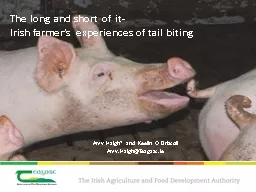

it Irish farmers experiences of tail biting Amy Haigh and Keelin ODriscoll AmyHaighTeagascie Origins First recognised but not a major problem Slatted floors began to displace deep straw bedded ID: 528382
Download Presentation The PPT/PDF document "The long and short of" is the property of its rightful owner. Permission is granted to download and print the materials on this web site for personal, non-commercial use only, and to display it on your personal computer provided you do not modify the materials and that you retain all copyright notices contained in the materials. By downloading content from our website, you accept the terms of this agreement.
Slide1
The long and short of
it-
Irish
farmer’s experiences of tail biting
Amy Haigh* and Keelin O’Driscoll
Amy.Haigh@Teagasc.ieSlide2
Origins
First recognised but not a major problem
Slatted
floors began to displace deep straw bedded
systems
Move from small
, extensive labour dependent enterprises into large, intensive capital dependent production systems
Tail
biting
surfaces
and
increases
in all countries and in all housing systems Slide3
72.5%
of study pigs (
Harley et al., 2014
) and moderate and severe tail lesions being present in 25.2%
and
3.1%
of pigs (
Van
Staaveren
et al., 2015
)
34.5
%
(
Valros
et al., 2004
) of pigs displayed tail lesions
53%
in a Dutch abattoir study
(
de
Lauwere
,
2009
). Of
700 individual piglets
=
95
%
was observed with tail damage at some stage
(
Zonderland
, 2011).
Slide4
Impacts
Camerlink
et al. (2012
)-
tail biting irrespective of the severity of wounds grew less well which corresponded to a weight difference of approximately
4 kg
at the end of the finishing period.
Correspondingly, Harley et al. (2014) found a significant negative effect of tail lesion severity on carcass weight, with a potential loss of
1.182kg
(
€0.59 per pig
). Slide5
The
wounded tail may become contaminated leading to abscesses of the hindquarters and the posterior segment of the spinal column
Secondary infection may occur in the lungs
Tail
lesion severity
was
significantly associated with carcass condemnation which accounted for up to
70%
of total carcass condemnations (Harley et al. 2014)
.
In Ireland
Harley et al. (2014) calculated an economic loss value of € 1.69
per study pig. Slide6
Proposed causes
Taken from Farewelldock.eu (
Bracke
, 2010)Slide7
58
respondents from 21 counties
Management
Size of farm, lines
Biggest negatives of tail biting
Frequency of biting behaviour
Patterns observed
Biggest triggers
Remedial solutions
EnrichmentSlide8
Reoccurring themes
“Tail biting is the biggest negative of pig production”
“Tail
biting happens sporadically”“Tail biting is horrible. The biggest negative for me is seeing a good pig destroyed”“Weak pigs are the most destructive. It will be one or two pigs who will do it
”
“The biggest problem with tail biting is trying to eliminate it
”
“Biting doesn’t occur very often but it is very serious
”Slide9Slide10
Range
Most common maternal
line
Landrace/Large white
Most common terminal
line
Danbred
Average 1
st
stage weaners per pen
42 (±25)
12-134
Average 2
nd
stage weaners per pen
32 (±17)
12-100
Average finishers per pen
26 (±11)
8-60
Percentage kept in mixed sex groups
69%
Percentage kept in single sex groups
31%
Percentage kept in same group from weaning
17%
Percentage mixed at all stages
66%
Slide11
Biggest concerns
“One
of the biggest negatives is having to isolate pigs”.
“If you don’t catch it in time and remove the bitten pig, there is no point sending it to the factory because it will be condemned”.“It could cost 80-90 euro to feed a pig that is than ruined”.“The welfare of the pig is the biggest negative of tail biting, it is clearly not comfortable”.Slide12
96%
had biting of some form on their farm that yearSlide13
Patterns observedSlide14Slide15Slide16
Supposed causesSlide17
1. Pig health
2. Density
3. Feed
4. Draught/ventilation
5. Temperature
6. Adequate feed space
7. Water quality
8. Healthy/even growth
9. Enrichment
10. Hygiene
11. Mixing
12. Background
13. Adequate light14. Natural light15. Breed
16. Bedding
17. Feed time
18. NoiseSlide18
In the event of an outbreak…Slide19
Enrichment
S
uggestions that tail biting behaviour is redirected exploration
behaviour.As one respondent commented “Use of bedding material would no doubt prevent it. In the old days it would never have been a problem, the pigs are bored.”
Many respondents believed that “
boredom has a big effect on tail biting
” and have found various methods successful in reducing it.
65
%
of
respondents
adding additional enrichment following an outbreak. One respondent stated that if there is the slightest sign of agitation he puts in wood. Slide20
Enrichment usedSlide21
Enrichment considerationsSlide22
81%
would consider additional enrichmentSlide23
Abnormal behaviours such as tail biting are significant problems on Irish farms with
96%
of respondents experiencing some form of biting in the last year.
Condemnation and loss of productivity
rank as the greatest concerns.
Ear biting
was found to peak in the
2
nd
stage
, while tail biting reached its apex in the
finishing stage.
Some of the biggest triggers were believed to be pig health, density/feed space and extremes in temperature
,
ventilation
and
dietary changes
.
Enrichment
was found to be useful in reducing the incidences of tail biting and stabilising it when it does occur, with 65% of respondents adding additional enrichment following an outbreak.
The biggest considerations when selecting enrichment included
effectiveness
and
longevity
, with chains, hanging devices and wood being used most commonly.
Summary of main pointsSlide24
Thank you for listening